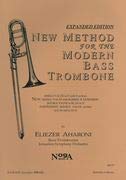
In this post we’ll be looking at some of the best bass trombone method books available. Bass trombonists have always had difficulty finding good methods and resources to learn from, probably because of the comparative newness of the modern double valve instrument when compared to other brass – especially the tenor trombone. However, we will also be looking at methods that are beneficial and appropriate for tenor trombone players seeking to improve their low range.
Bass Trombone Method Books for Beginners or Tenor Trombonists
Allen Ostrander: Method for Bass Trombone (and F attachment for Tenor Trombone)
Allen Ostrander: Method for Bass Trombone (and F attachment for Tenor Trombone)

Originally published in 1948 after teaching a bass trombone student at Julliard, this is one of the first study books aimed specifically at the bass trombone. It deals only with the F valve (and the related E/flat-F tunings) but despite this is still a great resource especially for intermediate players or tenor trombonists looking to explore the lower range more.
Included are: valve use exercises, progressive etudes and some orchestral excerpts.
And F Attachment for Tenor Trombone. Composed by Allen Ostrander. Classical. Student book. With Standard notation. Published by Carl Fischer (CF.O4517).
Lew Gillis: 70 Progressive Studies for the Modern Bass Trombonist
Lew Gillis: 70 Progressive Studies for the Modern Bass Trombonist

In a similar vein to the Ostrander book, this method is aimed at tenor trombonists who are moving to bass trombone. This bass trombone method book also only looks at the use of the F-attachment. The studies are well-marked with both valve suggestions and alternate positions.
The etudes are of intermediate difficulty and high musical quality and are ideal for beginner bass trombonists or tenor trombonists looking to develop the low register.
Included are: 40 F-attachment studies, 10 pedal note studies, and circles of 5ths scale studies.
General Bass Trombone Method Books
Alan Raph: The Double Valve Bass Trombone
Double Valve Bass Trombone by Alan Raph

This is one of the first trombone method books written with the double-trigger bass trombone in mind and covers the use of a few different possible valve tunings. Included are: the Single Valve in F, the Double Valve in flat E, the Double Valve in D, and the Independent 2nd Valve in Gb.
My only criticism is that the book spends too much time looking at the use of the valve in the upper register, something hardly ever required in performance. Nevertheless, this is still an excellent tutor for the use of both valves.
Here is a quote about the book from Tom Everett’s Annotated Guide to Bass Trombone Literature – “All aspects of playing requirements are covered with many of the exercises”.
Eliezer Aharoni: New Method for the Modern Bass Trombone
Eliezer Aharoni: New Method for the Modern Bass Trombone

Widely considered to be the best method available, this trombone method book covers everything a bass trombonist will need to master to reach professional competency. This method has the most extensive coverage of valve tunings and includes practically every system commonly used on the modern bass trombone.
The full list includes:
- Single Valve in F
- Single Valve with E pull
- Double Valve (side by side): Second valve in flat E, in Eb, and D
- In line: Bb – F – G – Eb, Bb – F – Gb – D, and long tuning slide on 2nd valve
- Single valve in F with a sliding E extension (“Slex”).
The Aharoni method also includes sections discussing the development of the bass trombone and the pros and cons of each valve tuning system.
I would recommend this book to every player serious about improving technical fluency. It thoroughly covers everything from learning the F-attachment onwards and can be used effectively by everyone from beginners to professionals.
In Conclusion
This collection of bass trombone method books should provide bass trombonists of varying levels with some great methods to learn from. These bass trombone method books will help trombonists who specialize in the tenor trombone to improve their low range.
